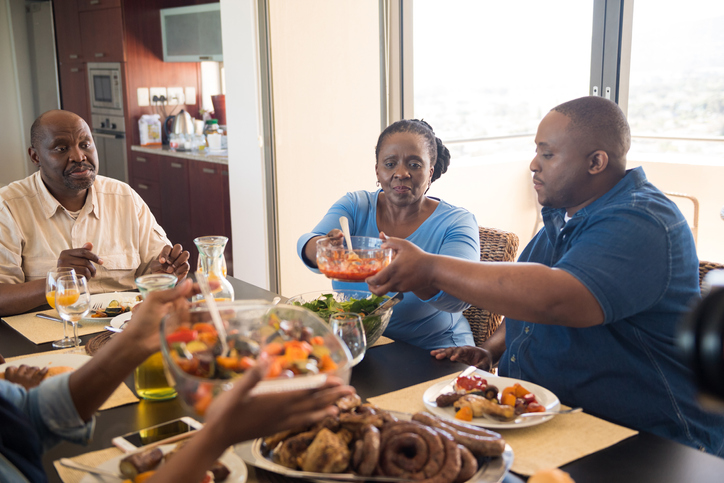It’s common for people trying to lose weight to have their own food and meals that are separate from the rest of the household. Here at gloji, we don’t believe in gimmicks and promote eating a balanced diet of real, nutrient rich foods. So, there’s no reason why your family shouldn’t eat the same foods as you. Sharing meals will save you time and headspace, and actually works out cheaper too.
Planning and cooking a healthy menu can be fun and educational. You can involve all children with age-appropriate tasks. From toddlers stirring and measuring to tweens and teens chopping, peeling, and using appliances, there’s a job for everyone.
If you’re not an experienced cook, remember that learning a skill together is a bonding activity which can strengthen your relationship.
Be a role model. By talking about nutritious foods and eating healthily in front of your family, you’re being a positive role model. If they see you enjoying a balanced diet, they’re more likely to follow suit.
Plan together. By doing this, you open communications about likes, dislikes and the importance of eating a balanced diet for our health and wellbeing. Use relevant analogies to connect with your children. For example, explain how eating protein can help their muscles grow strong which can make them run or swim faster, be better at football etc. Making a menu for the week doesn’t take long and means you won’t have to wrack your brains for something to cook after a long day.
Veggie boost. When you know what tastes your family enjoys, you can introduce new flavours and boost veg gradually. If mashed potato is popular, add small amounts of cauliflower, sweet potato, or swede. Increase the ratio over time to up the veggies even further.
Similarly, add veg like courgette and mushrooms to homemade tomato sauce for an added boost. Start by blending ingredients if it helps, and move towards finely diced, then roughly chopped until eventually everyone is eating chunks of various veg.
Share mealtimes. The way we eat is as important as what we eat. Shared mealtimes, focused on the present moment, enjoying the meal and company surrounding you is optimum. Self-esteem, communication skills, eating habits and even table manners are all elevated by family mealtimes. Even if you can’t do it daily, it’s worth making the effort to schedule them when you can.
Recipes that are easy, simple and provide a swift result are a great place to start. Some ideas include:
- Smoothies. If you’ve got a blender there are hundreds of recipes available online to try. Your children will enjoy chopping fruit, dolloping yoghurt, and pouring oats, not to mention whizzing it all up.
- Salads, wraps and sandwiches. There are no hard and fast rules for these. Combine a whole grain, protein like tinned fish or chicken and plenty of salad veg to make super healthy fast food. Using fun shaped cutters for sandwiches is appealing for tiny tots.
- Tomato sauce. Chop onion and garlic and cook with a little olive oil over a low heat until translucent, add tinned tomatoes or passata, a pinch of dried oregano, salt, and pepper and any other veg you fancy. Pop in a slow cooker for a few hours or leave on the hob for 45 mins, stirring regularly. Blend it to a smooth consistency for the fussiest of eaters or use a potato masher to break up veg. This sauce can then be eaten as is, or used as a base for bolognese, chilli and more.
- You can always leave out strong, pungent, or spicy flavours in your cooking and add at the dinner table for those who want them. Chilli flakes, fish sauce and tabasco are great additions.
Presentation is everything. We don’t mean Michelin starred restaurant plates. The way food is prepared and served creates interest, particularly for children. Try these tips to add convenience, intrigue, or novelty to eating well:
- Use mini milk bottles and paper straws or other fun glassware for smoothies.
- Stick food on a stick. Wooden kebab skewers seem to make everything a bit more interesting. Thread marinated chicken or fish with veg to make savoury skewers or berries, banana, and grapes for sweet ones.
- Love a lolly. Lollies are ace, whether you’re 3 or 53. Blend up fruit, yoghurt, nuts, seeds and even a little bit of veg (carrot or spinach are ideal) to make your very own superfood ice lollies.
- Spiralise veg or make ribbons with a peeler. Chop, dice, shred, or grate foods to create varying textures. Experiment with veg – steam, roast, boil, griddle or eat it raw.
- Grow foods together. Not only is growing your own food incredibly satisfying, but it’s also educational. Lots of fruit and veg are relatively simple to cultivate and even if you’ve no outside space, herbs can be grown in a pot on a windowsill.
- Healthy foods first. If we’re hungry, we’ll often eat the first foods available to us. By keeping a supply of nutrient rich foods like chopped veg sticks (carrot, celery, cucumber), fruit, chicken slices or yoghurt in the fridge, it makes healthy choices easier. Encourage your family to eat the rainbow.
- Make a polite bite policy. Taste buds change over time. It’s estimated we need to try certain foods at least 10 times before we can learn to like them. Encourage everyone in the household to take at least one bite of each food on offer. It doesn’t have to be a big bite, but it should be done without rudeness or pulling faces. Over time, you’ll find more and more foods are accepted and enjoyed.
Though it can be challenging, it’s never too late to make changes to your eating habits as a family. Small, sustainable changes are the easiest to implement and the most likely to stick. Use the opportunity to learn together and explore how a balanced diet can support your health and wellbeing.
Children absorb not only what we say to them but what we say and do around them. These factors contribute to their inner voice that will guide them into adult life. We can set our families up with a positive, knowledgeable mindset when it comes to health and wellbeing by providing and encouraging a balanced diet and active lifestyle.




